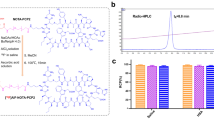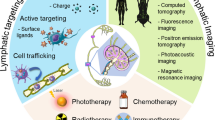Abstract
Introduction
Laser interstitial thermal therapy (LITT) remains a promising advance in the treatment of primary central nervous system malignancies. As indications for its use continue to expand, there has been growing interest in its ability to induce prolonged blood brain barrier (BBB) permeability through hyperthermia, potentially increasing the effectiveness of current therapeutics including BBB-impermeant agents and immunotherapy platforms.
Methods
In this review, we highlight the mechanism of hyperthermic BBB disruption and LITT-induced immunogenic cell death in preclinical models and humans. Additionally, we summarize ongoing clinical trials evaluating a combination approach of LITT and immunotherapy, which will likely serve as the basis for future neuro-oncologic treatment paradigms.
Results
There is evidence to suggest a highly immunogenic response to laser interstitial thermal therapy through activation of both the innate and adaptive immune response. These mechanisms have been shown to potentiate standard methods of oncologic care. There are only a limited number of clinical trials are ongoing to evaluate the utility of LITT in combination with immunotherapy.
Conclusion
LITT continues to be studied as a possible technique to bridge the gap between exciting preclinical results and the limited successes seen in the field of neuro-oncology. Preliminary data suggests a substantial benefit for use of LITT as a combination therapy in several clinical trials. Further investigation is required to determine whether or not this treatment paradigm can translate into long-term durable results for primary intracranial malignancies.



Similar content being viewed by others
References
Bettag M et al (1991) Stereotactic laser therapy in cerebral gliomas. Acta Neurochir Suppl (Wien) 52:81–83
Sugiyama K et al (1990) Stereotactic interstitial laser-hyperthermia using Nd-YAG laser. Stereotact Funct Neurosurg 54–55:501–505
Lee I, Kalkanis S, Hadjipanayis CG (2016) Stereotactic laser interstitial thermal therapy for recurrent high-grade gliomas. Neurosurgery 79(Suppl 1):S24–S34
Silva D et al (2017) Magnetic resonance thermometry and laser interstitial thermal therapy for brain tumors. Neurosurg Clin N Am 28(4):525–533
Beaumont TL et al (2018) Magnetic resonance imaging-guided laser interstitial thermal therapy for glioblastoma of the corpus callosum. Neurosurgery 83(3):556–565
Mohammadi AM et al (2014) The role of laser interstitial thermal therapy in enhancing progression-free survival of difficult-to-access high-grade gliomas: a multicenter study. Cancer Med 3(4):971–979
Hawasli AH et al (2014) Stereotactic laser ablation of high-grade gliomas. Neurosurg Focus 37(6):E1
Ali FS et al (2019) Cerebral radiation necrosis: incidence, pathogenesis, diagnostic challenges, and future opportunities. Curr Oncol Rep 21(8):66
Rahmathulla G et al (2012) Laser interstitial thermal therapy for focal cerebral radiation necrosis: a case report and literature review. Stereotact Funct Neurosurg 90(3):192–200
Sharma M et al (2016) Laser interstitial thermal therapy in the management of brain metastasis and radiation necrosis after radiosurgery: An overview. Expert Rev Neurother 16(2):223–232
North RY, Raskin JS, Curry DJ (2017) MRI-guided laser interstitial thermal therapy for epilepsy. Neurosurg Clin N Am 28(4):545–557
Prince E et al (2017) Laser interstitial thermal therapy for epilepsy. Curr Neurol Neurosci Rep 17(9):63
Shukla ND et al (2017) Laser interstitial thermal therapy for the treatment of epilepsy: evidence to date. Neuropsychiatr Dis Treat 13:2469–2475
Wicks RT et al (2016) Laser interstitial thermal therapy for mesial temporal lobe epilepsy. Neurosurgery 79(Suppl 1):S83–S91
Pisipati S et al (2016) Intracerebral laser interstitial thermal therapy followed by tumor resection to minimize cerebral edema. Neurosurg Focus 41(4):E13
Wright J et al (2016) Laser interstitial thermal therapy followed by minimal-access transsulcal resection for the treatment of large and difficult to access brain tumors. Neurosurg Focus 41(4):E14
Salem U et al (2019) Neurosurgical applications of MRI guided laser interstitial thermal therapy (LITT). Cancer Imaging 19(1):65
Leuthardt EC et al (2016) Hyperthermic laser ablation of recurrent glioblastoma leads to temporary disruption of the peritumoral blood brain barrier. PLoS ONE 11(2):e0148613
Mansor NI et al (2019) Crossing the blood-brain barrier: a review on drug delivery strategies for treatment of the central nervous system diseases. Curr Drug Deliv 16:698–711
Hersh DS et al (2016) Evolving drug delivery strategies to overcome the blood brain barrier. Curr Pharm Des 22(9):1177–1193
Weiss N et al (2009) The blood-brain barrier in brain homeostasis and neurological diseases. Biochim Biophys Acta 1788(4):842–857
Wang Z, Sun H, Yakisich JS (2014) Overcoming the blood-brain barrier for chemotherapy: limitations, challenges and rising problems. Anticancer Agents Med Chem 14(8):1085–1093
Zhan C, Lu W (2012) The blood-brain/tumor barriers: challenges and chances for malignant gliomas targeted drug delivery. Curr Pharm Biotechnol 13(12):2380–2387
Ostermann S et al (2004) Plasma and cerebrospinal fluid population pharmacokinetics of temozolomide in malignant glioma patients. Clin Cancer Res 10(11):3728–3736
Pombo Antunes AR et al (2020) Understanding the glioblastoma immune microenvironment as basis for the development of new immunotherapeutic strategies. eLife. 9:e52176
Aldape K et al (2019) Challenges to curing primary brain tumours. Nat Rev Clin Oncol 16(8):509–520
Tomaszewski W et al (2019) Brain tumor microenvironment and host state: implications for immunotherapy. Clin Cancer Res 25(14):4202–4210
Tabatabai G et al (2006) Irradiation and hypoxia promote homing of haematopoietic progenitor cells towards gliomas by TGF-β-dependent HIF-1α-mediated induction of CXCL12. Brain 129(9):2426–2435
Tseng D, Vasquez-Medrano DA, Brown JM (2011) Targeting SDF-1/CXCR4 to inhibit tumour vasculature for treatment of glioblastomas. Br J Cancer 104(12):1805–1809
Vogelbaum MA et al (2018) First-in-human evaluation of the Cleveland Multiport Catheter for convection-enhanced delivery of topotecan in recurrent high-grade glioma: results of pilot trial 1. J Neurosurg 130:476–485
Brown CE et al (2016) Regression of glioblastoma after chimeric antigen receptor T-cell therapy. N Engl J Med 375(26):2561–2569
Eichberg DG et al. (2019) multiple iterations of magnetic resonance-guided laser interstitial thermal ablation of brain metastases: single surgeon's experience and review of the literature. Oper Neurosurg (Hagerstown)
Goldberg SN, Gazelle GS, Mueller PR (2000) Thermal ablation therapy for focal malignancy: a unified approach to underlying principles, techniques, and diagnostic imaging guidance. AJR Am J Roentgenol 174(2):323–331
Mirza FN, Khatri KA (2017) The use of lasers in the treatment of skin cancer: a review. J Cosmet Laser Ther 19(8):451–458
Weston AP, Sharma P (2002) Neodymium:yttrium-aluminum garnet contact laser ablation of Barrett's high grade dysplasia and early adenocarcinoma. Am J Gastroenterol 97(12):2998–3006
Ellis MJ et al (2018) Management of an adolescent athlete with sports-related concussion and intraparenchymal hemorrhage. Curr Sports Med Rep 17(1):7–9
Vacchelli E et al (2014) Trial watch: chemotherapy with immunogenic cell death inducers. Oncoimmunology 3(1):e27878
Ma Y et al (2019) Near-infrared II phototherapy induces deep tissue immunogenic cell death and potentiates cancer immunotherapy. ACS Nano 13(10):11967–11980
Kiyatkin EA, Sharma HS (2009) Permeability of the blood-brain barrier depends on brain temperature. Neuroscience 161(3):926–939
Wang H et al (2014) Brain temperature and its fundamental properties: a review for clinical neuroscientists. Front Neurosci 8:307
Yamaguchi T et al (2019) Effect of heat stress on blood-brain barrier integrity in iPS cell-derived microvascular endothelial cell models. PLoS ONE 14(9):e0222113
Ji C et al (2016) Hyperthermia exacerbates the effects of cathepsin L on claudin-1 in a blood-brain barrier model in vitro. Brain Res 1631:72–79
Chen YZ et al (2003) Effect of hyperthermia on tight junctions between endothelial cells of the blood-brain barrier model in vitro. Di Yi Jun Yi Da Xue Xue Bao 23(1):21–24
Sabel M et al (2003) Locoregional opening of the rodent blood-brain barrier for paclitaxel using Nd:YAG laser-induced thermo therapy: a new concept of adjuvant glioma therapy? Lasers Surg Med 33(2):75–80
Appelboom G et al (2016) Stereotactic modulation of blood-brain barrier permeability to enhance drug delivery. Neuro Oncol 18(12):1601–1609
Rossmann C et al (2017) Temperature sensitive liposomes combined with thermal ablation: effects of duration and timing of heating in mathematical models and in vivo. PLoS ONE 12(6):e0179131
Mehta A, Oklu R, Sheth RA (2016) Thermal ablative therapies and immune checkpoint modulation: can locoregional approaches effect a systemic response? Gastroenterol Res Pract 2016:9251375
Kakinuma K et al (1996) Drug delivery to the brain using thermosensitive liposome and local hyperthermia. Int J Hyperthermia 12(1):157–165
Kakinuma K et al (1996) Targeting chemotherapy for malignant brain tumor using thermosensitive liposome and localized hyperthermia. J Neurosurg 84(2):180–184
Bredlau AL et al (2018) Localized delivery of therapeutic doxorubicin dose across the canine blood-brain barrier with hyperthermia and temperature sensitive liposomes. Drug Deliv 25(1):973–984
Kwiatkowski S et al (2018) Photodynamic therapy-mechanisms, photosensitizers and combinations. Biomed Pharmacother 106:1098–1107
Lim CK et al (2013) Nanophotosensitizers toward advanced photodynamic therapy of Cancer. Cancer Lett 334(2):176–187
Agostinis P et al (2011) Photodynamic therapy of cancer: an update. CA Cancer J Clin 61(4):250–281
Dolmans DE, Fukumura D, Jain RK (2003) Photodynamic therapy for cancer. Nat Rev Cancer 3(5):380–387
Eljamel S (2010) Photodynamic applications in brain tumors: a comprehensive review of the literature. Photodiagnosis Photodyn Ther 7(2):76–85
Cramer SW, Chen CC (2019) Photodynamic therapy for the treatment of glioblastoma. Front Surg 6:81
Zhou F et al (2015) InCVAX–a novel strategy for treatment of late-stage, metastatic cancers through photoimmunotherapy induced tumor-specific immunity. Cancer Lett 359(2):169–177
Qi X et al (2016) Development of inCVAX, In situ Cancer Vaccine, and Its Immune Response in Mice with Hepatocellular Cancer. J Clin Cell Immunol. https://doi.org/10.4172/2155-9899.1000438
Naylor MF et al (2017) Treatment of advanced melanoma with laser immunotherapy and ipilimumab. J Biophoton 10(5):618–622
Laman JD, Weller RO (2013) Drainage of cells and soluble antigen from the CNS to regional lymph nodes. J Neuroimmune Pharmacol 8(4):840–856
Tran D et al (2019) SCIDOT-43. Final data analysis of a pilot study testing the efficacy of using laser interstitial thermal therapy (LITT) to induce temporary disruption of the peritumoral blood brain barrier (BBB) to improve effectiveness of BBB-impermeant chemotherapy in recurrent glioblastoma. Neuro Oncol 21(6):6280–6281
Campian J et al (2019) ATIM-45. long term follow-up of a phase I/II study testing the toxicities and efficacy of pembrolizumab in combination with MRI-guided laser interstitial thermal therapy (LITT) in recurrent malignant gliomas. Neuro Oncol 21(6):611
Ali SC et al (2018) The safety of bevacizumab administered shortly after laser interstitial thermal therapy in glioblastoma: a case series. World Neurosurg 117:e588–e594
Verdegaal EM (2016) Adoptive cell therapy: a highly successful individualized therapy for melanoma with great potential for other malignancies. Curr Opin Immunol 39:90–95
De Santis CE et al. (2019) Breast cancer statistics 2019. CA Cancer J Clin.
DeSantis CE et al (2014) Cancer treatment and survivorship statistics, 2014. CA Cancer J Clin 64(4):252–271
Author information
Authors and Affiliations
Corresponding authors
Ethics declarations
Conflicts of interest
David H. Shin declares that he has no conflict of interest. Kaitlyn F. Melnick declares that she has no conflict of interest. David D. Tran is one of the primary investigators in the referenced trial at this institution (NCT02311582). David D. Tran also has received grant funding from Celldex, NWBiotech, Novocure, and Merck. David D. Tran has received personal fees from Novocure and prIME Oncology. Ashley P. Ghiaseddin has received personal fees from Monteris Medical. Ashley P. Ghiaseddin has also received research funding support from Orbus Therapeutics.
Research involving human participants and/or animals
All procedures performed in studies involving human participants were in accordance with the ethical standards of the institutional and/or national research committee and with the 1964 Helsinki declaration and its later amendments or comparable ethical standards.
Informed consent
Informed consent was obtained from all individual participants included in this study.
Additional information
Publisher's Note
Springer Nature remains neutral with regard to jurisdictional claims in published maps and institutional affiliations.
Rights and permissions
About this article
Cite this article
Shin, D.H., Melnick, K.F., Tran, D.D. et al. In situ vaccination with laser interstitial thermal therapy augments immunotherapy in malignant gliomas. J Neurooncol 151, 85–92 (2021). https://doi.org/10.1007/s11060-020-03557-x
Received:
Accepted:
Published:
Issue Date:
DOI: https://doi.org/10.1007/s11060-020-03557-x




